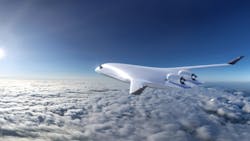ADI and JetZero Announce Demonstrator Milestones for All-Wing Airplane
Applied Dynamics International (ADI) and JetZero, the company developing the Z4, an all-wing airplane, announced the successful achievement of key demonstrator milestones.
JetZero’s Flying Qualities Lab (FQL) has integrated pilot controls, including Safran throttle, rudder pedals, flap and speed brake handles, Woodward trim panel and BAE Systems active control sidesticks.
JetZero’s FQL is a test and evaluation platform where pilots and engineers can develop the flight control laws (CLAW), connected to a physics-based real-time simulation of the full all-wing airplane. As laws are developed in the FQL, they are then transferred to the ITF for the next step in testing.
JetZero’s Integration Test Facility (ITF) lab has also achieved milestones with the integration of the Thales Flight Control Computers (FCC) hardware and software to the pilot controls, including BAE Systems active control sidesticks, enabling pilot-in-the-loop testing of the flight control system.
These milestones allow for Z4 interoperability testing of the airplane equipment, prior to installation in the full-scale demonstrator airplane. JetZero’s ITF is an advanced test and evaluation platform where the airplane electrical and electronic systems are installed and taken through interoperability and performance testing in a simulated flight environment.
One of JetZero’s missions is “solving for time.” Through JetZero’s digital engineering and lab strategy, they aim to accelerate development of a Part 25-Transport Category Airplane.
JetZero team members have backgrounds at major manufacturers and system suppliers and understand the related complexities. The JetZero demonstrator airplane uses components already flying on Part 25 airplanes to reduce risk. The main challenge is integration. That’s where labs are essential, preventing surprises and reducing risk.
JetZero is using a three-lab approach to decouple systems integration from airframe construction, running both in parallel. This accelerates development by building the airplane while ensuring systems are ready when the airframe is complete. The three labs include: a Flying Qualities Lab, an Integration Test Facility and an Iron Bird.
“Many of us entered this field with excitement about building incredible aircraft, but bureaucracy and antiquated tools can dampen that spirit,” said Bethany Davis, head of airplane systems and labs at JetZero.
Davis continued, “That’s why the Air Force emphasizes ‘buying back time’ and strongly supports our digital tools, lab-driven rapid prototyping approach. It’s a strategic move to accelerate critical aerospace capabilities.”
The partnership between ADI and JetZero began due to ADI’s experience developing and deploying the industry’s top aerospace and defense digital twin platform and a track record accelerating the airplane development journey through flight test and type certification.
“Traditional aerospace development required experts in one location,” said Scott James, ADI’s president and CEO, “The use of remotely accessible labs, enabled by our ADEPT edge computing platform, changes the calculus.”
James added, “A test engineer in Florida can pilot the simulation-based flight test, while a control systems expert in Montreal and a hydraulics specialist in Michigan work on the same test in real-time, each seeing the data and analytics they need. This real-time collaboration, regardless of location, brings specialized insights together more efficiently than ever.”
Remote testing helps solve a challenge for commercial OEMs: finding and keeping specialized talent. Team members come in for physical tests but can work from anywhere once remote environments are ready. This has helped JetZero build a global operation, with team members across the U.S. and the world.
